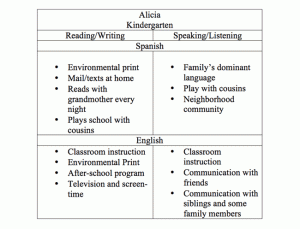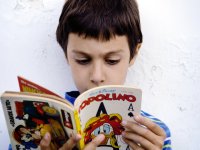Don’t Say “Your Child Can’t Read”
Before making assumptions about literacy, study young children’s oral and written language development patterns while striving to understand their lives outside of school and watching them play.
Your content has been saved!
Go to My Saved Content.As someone who has been fortunate enough to spend much of her professional career working in elementary schools -- both as an early-childhood (K-3) teacher and university-based teacher educator -- I'm often struck by the difference between how young children and teachers talk about literacy in the earliest years of school. Whether they're drawing pictures and asking you to "read" their latest story or eagerly inviting you to listen to an account of a favorite book, young children enter school enthusiastic about learning to read and write. In a world where they see print all around them -- scrolling on phone screens, in the books that they love, on the billboards they ponder -- learning to read and write makes a young child feel independent and capable.
Yet early-childhood teachers point to the pressures associated with the Common Core State Standards and the accompanying standardized testing culture as deeply affecting classrooms, often characterized by a heightened focus on teaching young children to read and write as early as possible.
Early Indicators of Literacy
It is not uncommon to hear stories of materials that once embodied the early-childhood classroom -- building blocks, water tables, play manipulatives -- being replaced with worksheets, letter tiles, and homework reading logs. With such pressure, early-childhood teachers are forced to change the ways that they assess and qualify children's abilities and learning processes. A child once described as a risk taker, imaginative, or a leader is now described as a level-B reader or conventional speller. And all too often, this means that before parents hear any other impactful messages from teachers or school, they might hear the words: "Your child can't read."
While the early years of school are critically important to short- and long-term academic success, children enter school inherently curious and intellectually ready, such that being a reader should be just one part of their academic identity. So, before describing a young child as a "non-reader," consider these three suggestions for honoring our longstanding commitment to developmentally and culturally responsive pedagogy, even as the ground under our feet shifts.
1. What do you know about the child's oral language development? Does the child bring an understanding of more than one language to his or her learning?
Increasingly more young children are entering kindergarten with an understanding of more than one language. While both research and human experience demonstrate the value of multilingualism, the benefits are often attributed to adult characteristics like future employment or global travel. The misconception that I most often hear about early childhood is that it's confusing for multilingual children to communicate or learn to read and write. This statement is anything but true! As young children navigate uncharted cognitive pathways, they make sense of their world through the filter of more than one language, and research suggests that requires sophisticated social and critical thinking skills. So think of multilingualism as an opportunity. Inquire about the child's language diversity, and use the opportunity to meet with the parent and make a chart like the one below to deepen your understanding of the family's linguistic diversity:

2. Does the child "pretend" to read and write? How does this relate to his or her literacy development?
Play is the blueprint that young children develop to construct meaning within their world. In addition, play can be a linguistically rich space for children, as their desire to participate in a playful experience supports a learning context to engage in more sophisticated language use. For this reason, play becomes a powerful means for young children to develop and expand on their understandings of reading and writing.
One way that children often do so is through pretending to read and write in their social interactions and play. Rather than dismissing these practices as non-conventional literacy knowledge, teachers should carefully observe a child as he plays. Is he making strings of letter-like formations and saying that it "reads" as a story that can be shared? This is profoundly symbolic, revealing his understanding that a story is something represented in text, narrated, and communicated with others. Does a child "memorize" a book but have difficulty decoding a word in isolation? Praise her for expanding her memory, recognizing that words work together to produce meaning, and use that memorized text as an opportunity to teach her about the concepts of print like directionality, letters, and words.
So watch that child at play, whether on the playground or in class, and be ready to record the many ways that you might connect the play with your reading and writing instruction and goals.
3. Is the child interested in printed text both in and out of school? How can a teacher and parent build on that interest?
For some children, reading and writing instruction in school can be difficult. However, children come to school with many different life experiences and often reveal interests that can support our traditional reading and writing instruction. Rather than limiting our knowledge of early literacy to letters and schoolbooks, a deeper understanding of children's out-of-school experiences can serve as a resource for uncovering their literate lives. For example, does the child enjoy playing video games or cell phone apps? What print accompanies those apps, and how might a teacher use that knowledge to support her reading instruction? Does a child love a particular toy collection with an accompanying leaflet that describes the figure in detail? How can such an expository text be used as leverage into a discussion about nonfiction reading and writing? While the curricular programs used in our schools often govern our instruction, by understanding our students' literate lives, we begin to understand how we can become more fully inclusive.
The Language We Use
With each of the examples discussed above, it's critically important to have a range of different data, acknowledging the variance of demonstrated reading and writing skills and knowledge from child to child. Assigning the harmful label "he cannot read" is an example of why this matters so much. It's also important to recognize that some children have legitimate learning and reading difficulties. However, when these cases arise, it requires even greater attention to these types of considerations, as well as sensitivity to the language that we use with parents. Let's establish a safe and inclusive space to partner with them -- for the good of the child.
How do you encourage young learners to explore and embrace literacy?
